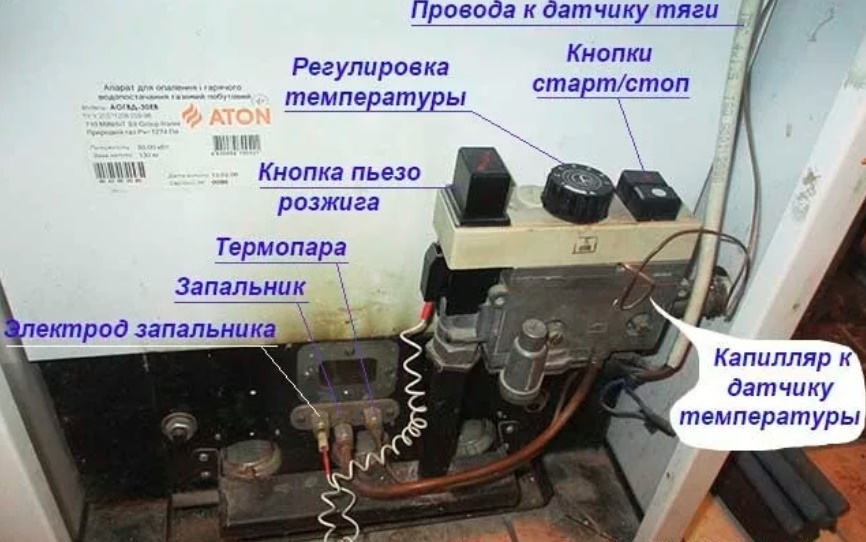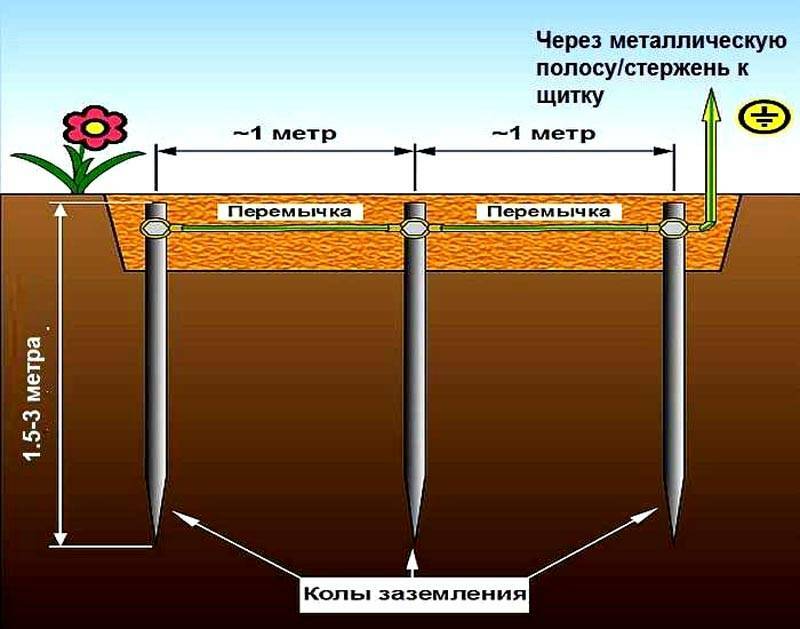All owners of private houses would like to get an autonomous heating system with the least investment. It remains to decide which is better - a gas or electric boiler, if both of these sources of energy are available.
In fact, this task is not very simple, since in addition to the variety of prices for equipment, there are many more nuances regarding connection, registration of documents and energy tariffs. If you take a serious approach to solving this issue, you can get an informed answer to it and make the right choice in the end.
Let's figure out together which version of the unit and the heating based on it will be more practical. The article presented by us provides an assessment of the cost of installation work and a comparison of economic indicators. The information we provide will help you make the right choice.
The content of the article:
-
Features of heating from electricity
- Consumption rates and limits
- Purchase and installation of an electric boiler
-
Gas heating specifics
- How to connect to the backbone system
- Features of equipment installation
- Comparison of energy tariffs
- Total cost comparison
- Conclusions and useful video on the topic
Features of heating from electricity
For each house or cottage, you need to determine the types of work required, draw up an individual estimate and get the amount that will eventually need to be paid for the heating system. You also need to calculate the amount of electricity or gas required for the cold season, and knowing their cost, it is easy to calculate the annual costs.
Electric boilers that are used to heat a country house are classified as high-power consumers. It follows from this that in most cases it will be necessary to incur costs not only for the purchase and installation of equipment, but also for the alteration of the power supply system.
Consumption rates and limits
To determine the required power of an electric or gas boiler, you need to calculate the heat loss at home.
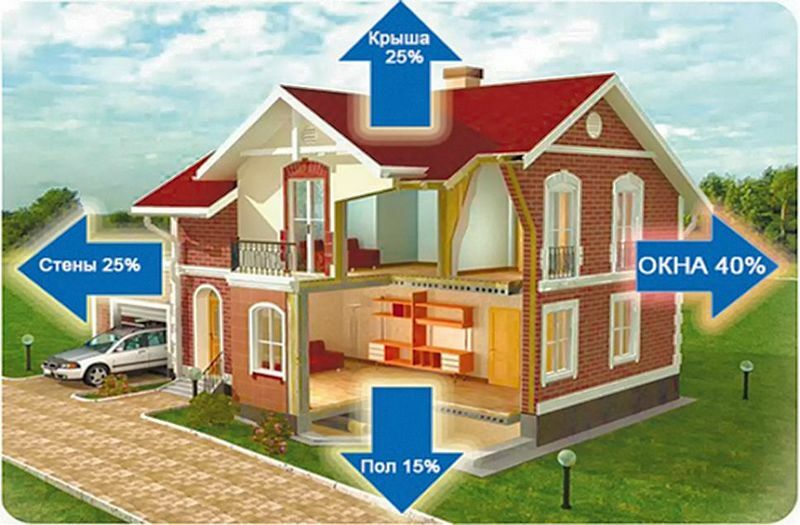
If you calculate in detail the structure of heat loss at home, then you can take effective measures to insulate it. This will help save on heating costs.
Heat loss has two meanings:
- The average, which is calculated based on the average daily temperatures for the entire heating period (QWed). It is used to calculate the amount of energy consumed per year (gas, electricity, firewood, fuel oil, etc.).
- Maximum, which is determined by the temperature of the coldest five-day week (QMax). It is used to calculate the minimum permissible boiler output.
During the period of peak cold weather, the boiler can work continuously, and during temperatures close to the normative ones, the coolant circulating along the heating circuit is periodically heated.
Heat loss values can be obtained in several ways:
- calculate yourself using simplified methods or special calculators;
- calculate it yourself, using more accurate calculations using the thermal resistance parameter of the materials from which the house is built;
- order calculations for third-party organizations.
Any boiler must be selected according to the parameter of the maximum thermal power (PMax) given the following condition:
PMax ≥ QMax / (K / 100), where
K - equipment efficiency.
The efficiency of modern electric heaters is equal to or exceeds 98%, and gas heaters are usually in the range from 92% to 96%.
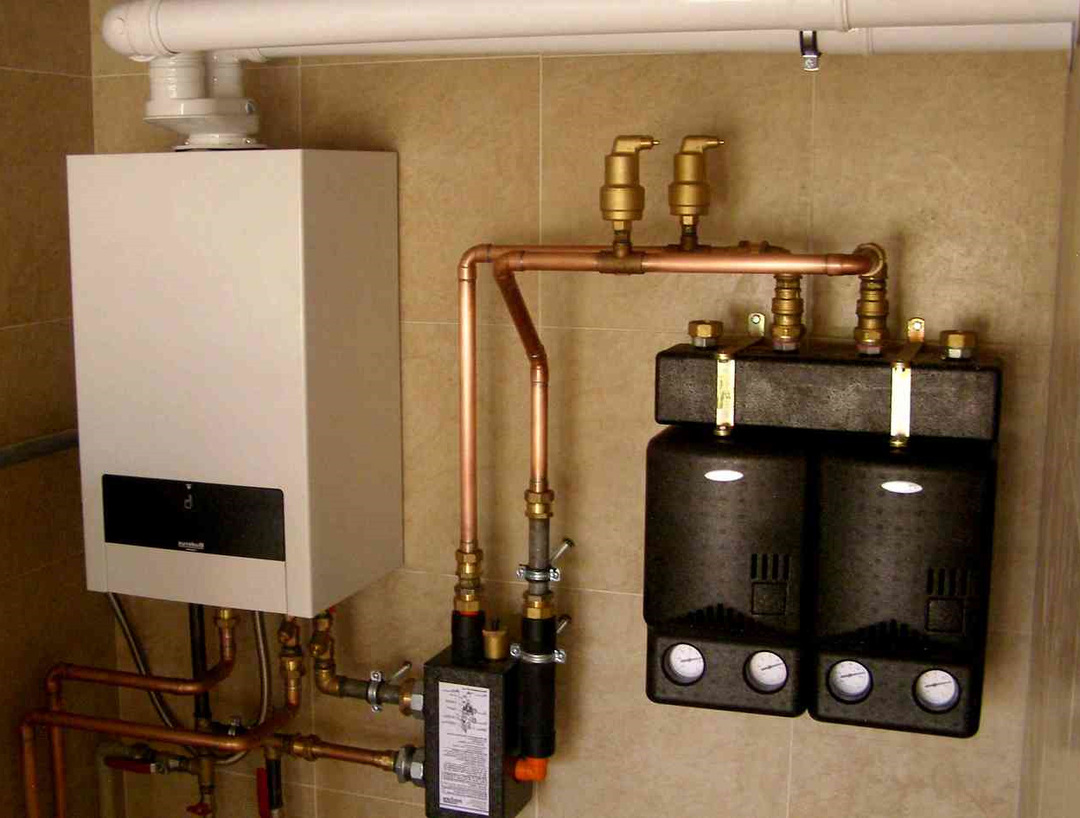
Double-circuit boilers are equipped with a hot water circuit. This leads to additional energy consumption, which must also be taken into account.
Having calculated the required maximum boiler power, it is necessary to determine the possibility of its connection to the network. For small buildings, it is sometimes possible to keep within the normative 15 kW, which the power supply organization is obliged to provide to the consumer who is an individual.
According to the Decree of the Government of the Russian Federation No. 1178 dated December 29, 2001 (in the current edition) the cost of technological connection in this case is now only 550 rubles.
If the required power exceeds 15 kW or the networks are located at a distance of more than 500 meters (within the city limits - 300 meters) from the object, then the price for connection will be higher. It can depend on many factors, so it is easier to find out from the power supply organization by sending an appropriate request.
In addition, the applicant can be given a reasoned refusal for such a connection if there is a technical problem, for example, overloading a substation.
Purchase and installation of an electric boiler
One of the clear advantages of the electric boiler over its gas counterpart is the ease of installation and the possibility of its installation almost anywhere in the house.
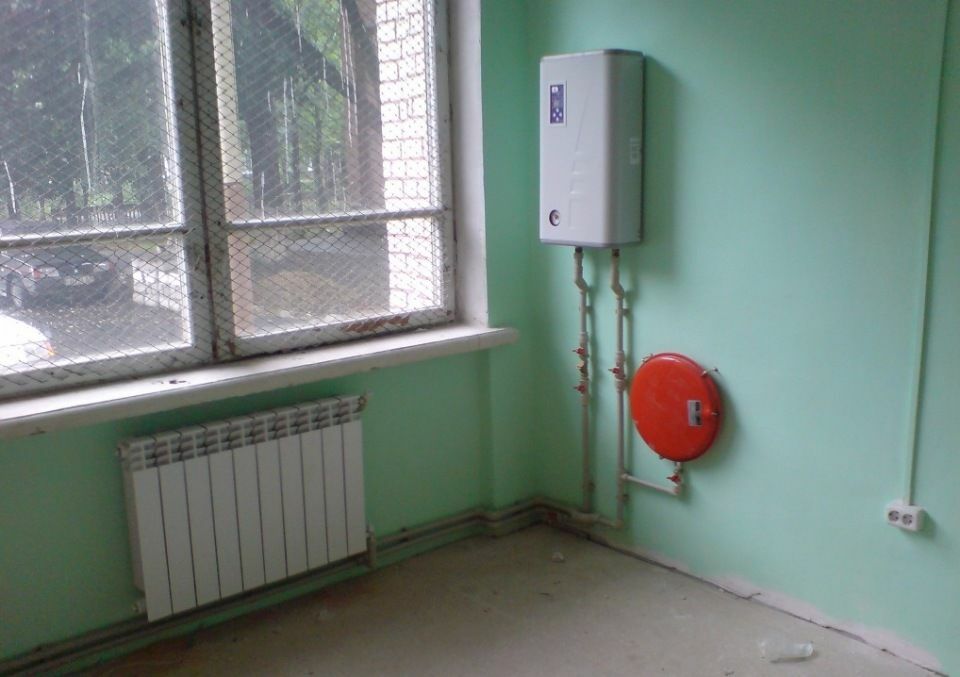
Electric boilers do not require a separate room with normalized ventilation and do not need a chimney to be connected to them. They are also easy to fit into the interior.
If you compare what will be more profitable in the end - an electric or gas boiler, then you need to ignore those works that are the same in price for any type of equipment. For example, the installation of a water circuit around the perimeter of a house does not depend on the type of energy source supplied.
Therefore, when installing an electric boiler, the following financial costs must be taken into account:
- connection to the heating circuit (piping);
- ensuring the supply of electricity;
- placement and connection of the heat accumulator.
The heat accumulator is relevant when using a two-zone tariff. It allows you to store heat at night when the cost of electricity is much lower.
Gas heating specifics
The procedure for obtaining permission to connect to the mains, install gas equipment and start it up is more complicated than for boilers powered by electricity. Therefore, it is quite difficult to calculate the costs yourself and you will have to contact the organizations responsible for gas delivery and installation of systems.
How to connect to the backbone system
All work carried out on the territory located outside the private property is carried out by the gas supply organization.

Gas can be supplied to the house by an underground or air method. The second option is less attractive, since it imposes restrictions, for example, on the trajectory of the arrival of personal vehicles on the site
First of all, you need to collect a package of documents and get technical conditions with calculation of payment for technological connection.
Typically, an individual is classified in the first category of applicants who meet the following conditions:
- gas consumption no more than 20 m3 / hour;
- network operating pressure 0.3 MPa;
- distance in a straight line to the network 200 m.
These parameters are specified in p. 2 Decree of the Government of the Russian Federation No. 1314 of December 30, 2013 in the current edition of February 21, 2019 The cost of technological connection (including VAT) for the first group is set in the range from 20 to 50 thousand rubles. and depends on regional tariff rates.
However, the presence of a fragment of the gas network near the site does not mean that it is possible to connect to it, since it is possible that the entire capacity of this branch has already been selected. In the event that the pipes have to be pulled from afar, or additionally install a gas distribution pressure reducing equipment, the cost of work can rise significantly, up to several million rubles.
Also, the presence of ravines, reservoirs, roads with asphalt concrete pavement and other obstacles on the way, layering to the house, if you need to overcome them additional work.

Another disadvantage of using gas is a lot of documents that must be provided to the gas supplying organization. This can also be accounted for in monetary terms.
The next type of cost is the implementation of gas communications on the site. The owner must pay for them. It is important to know here that such work can be carried out by any company with SRO approval. Very often, the cost of design and construction at the client's site with gas supply organizations, with whom it will be necessary to conclude a contract for the construction of the system and connection and maintenance, is overstated.
Since gas pipelines are classified as high-risk facilities, construction and installation work must be carried out only after a series of studies, which are also paid by the owner:
- preparation of a topographic plan of the site;
- gas supply project development;
- coordination of the project in the services (architecture, electricians and gas workers);
- registration of the project with gas workers.
Upon completion of the installation of the gas boiler, the final procedure will follow, which also requires cash investments - putting the entire system into operation: checking the compliance of the facility with the requirements, conclusion of a contract, final paperwork and commissioning.
Features of equipment installation
The use of gas requires compliance with safety rules that are more complex than those for electricity. Therefore, placement and installation of a gas boiler must be carried out in accordance with SNiP 41-01-2001 (p. 6.14-6.15). If inconsistencies with this document are found, the heating system will not be accepted by a gas service specialist.
In order to comply with the requirements for ventilation and the removal of combustion products for a floor-standing gas boiler, it is imperative that a separate room is allocated - a boiler room. This also entails additional costs, especially if this room was not originally foreseen in the building design.
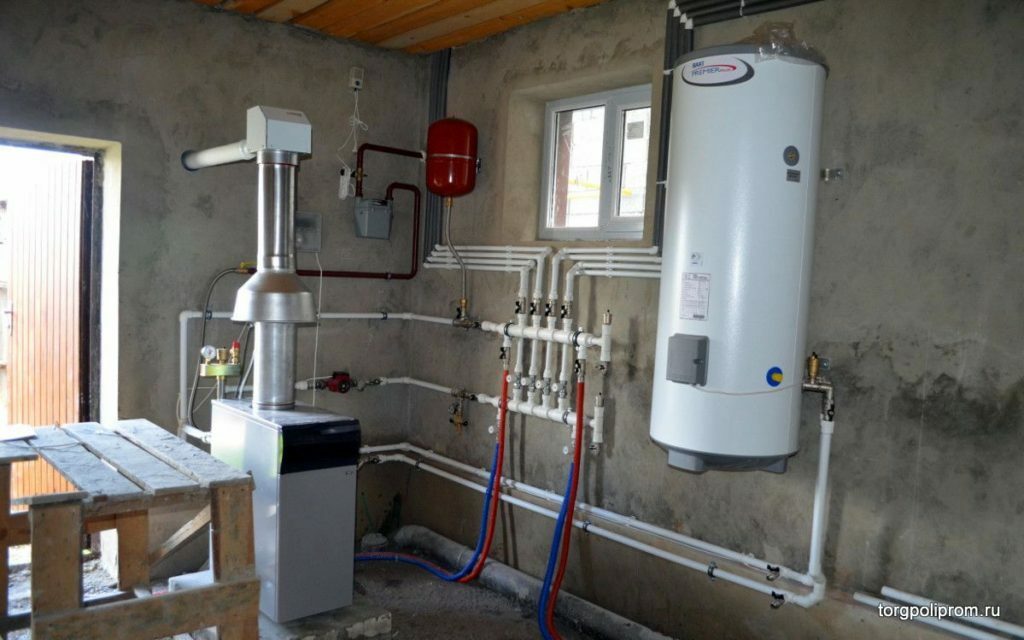
In addition to high-quality ventilation, the boiler room must comply with fire safety requirements, as well as provide easy access to all equipment
The entire list of work required for the installation of a gas boiler includes the following steps:
- placing the boiler on the floor or wall;
- connection to the heating circuit (piping);
- mounting chimney for gas boiler;
- first heating start and setting.
The combustion products removal system for gas heating equipment has its own specifics. The temperature at the beginning of the chimney will be significantly lower than that of stoves or solid fuel boilers.
Therefore, you need to follow all the rules for the diameter and slope of pipes, their location outside the building and insulation. Otherwise, the boiler automation may react to insufficient draft and block its operation.
Comparison of energy tariffs
The cost of energy carriers is regulated by the order of the Federal Tariff Service No. 20-e / 2 dated 06.08.2004. For the population, as retail consumers, the price of a unit of electricity (kWh) and gas (m3) may differ depending on the conditions of their production and delivery to the end user.
Tariffs are published on the websites of the administrations of districts, cities and subjects of the Russian Federation. You can also find them out by contacting the company that supplies the energy carrier, or the housing and communal services department of the local administration.
In any case, in the Russian Federation, in terms of heat generated, main gas is much cheaper electricity.
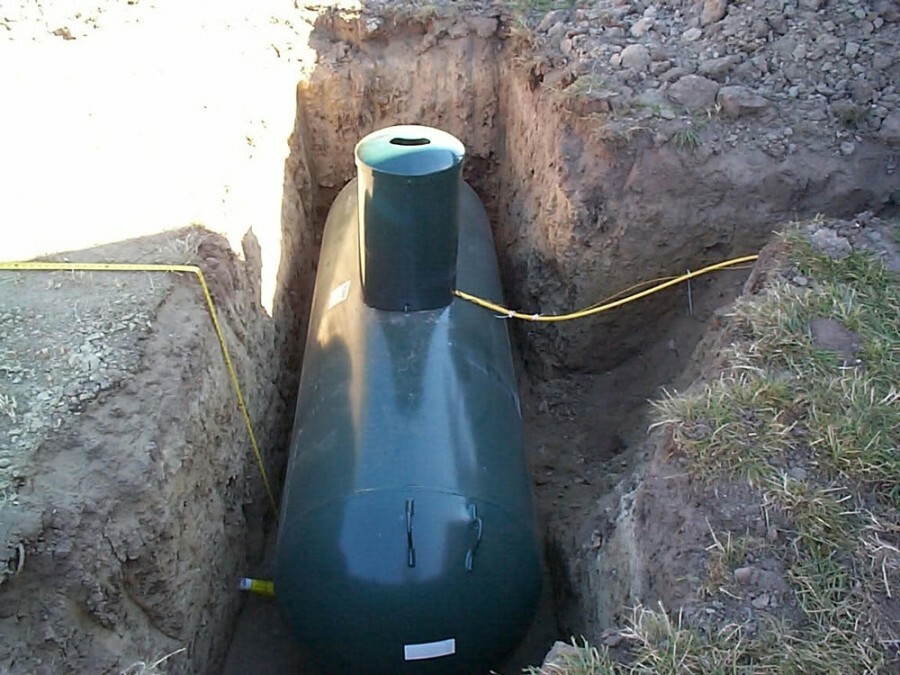
The price per unit of heat when burning liquefied gas is practically equal to the cost of electricity. Considering the cost of the gas tank, heating from a propane-butane mixture loses to other options
There are two more nuances to calculate the cost of consumed electricity:
- Possibility to reduce the tariff by 30% for premises that are located within city limits and are equipped with stationary electrical heating devices. This is possible if some formal procedures were followed at the design stage of the house.
- Possibility of using a multi-tariff option. To stimulate consumption at night (when there is a decline in the total load on the network), the supplying organizations lower the cost per kWh. This allows you to significantly save on electricity bills.
When calculating the use of a reduced rate at night, remember that in this case you need there will be a heat accumulator, and the boiler power must be higher in order to provide a heat reserve for whole day.
Total cost comparison
On average, the cost of an electric boiler is not much lower than that of a gas boiler, and with the use of a heat accumulator it can be even higher. However, the price for electricity connection services is significantly less than when laying a gas pipe and obtaining all operating permits.
Thus, the one-time costs for the installation of equipment and the supply of communications for gas are higher than for electricity.
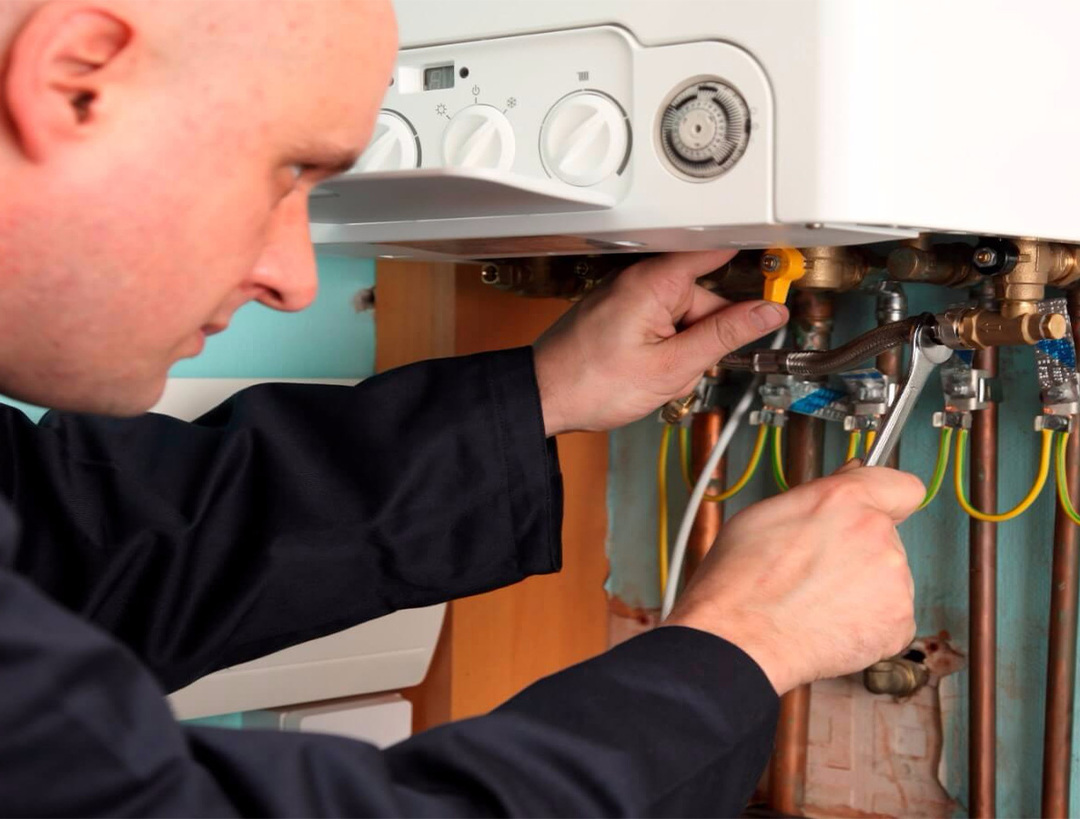
Some of the procedures for providing heating can be done independently. But when calculating the final cost of all costs, you still need to take into account your labor, since it should also be appreciated
Taking into account that, in terms of the released heat, the price of gas is lower than that of electricity, the following situation is obtained:
- Electricity heating can be installed. Pros - the relatively low cost of equipment and work, ease of installation and variability in choosing the location of the boiler.
- You can opt for heating from mains gas. Plus - an economical type of energy carrier, which after a while will beat off the initial costs.
To calculate the period T (year), during which heating from gas will become more profitable than from electricity, you need to solve the following equation:
T = (NG - NNS) / (LNS - LG), where:
- NG - one-time costs for the installation of gas equipment and communications (r.);
- NNS - the same for electricity (p.);
- LG - annual costs for gas payments and equipment maintenance (p. / year);
- LNS - the same for electricity (p. / year).
Let's determine which boiler is better - electric or gas on the example of a real object. House in the area of g. Belgorod, area 100 m2. Estimated heat loss for the heating period is 3500 W, and for the coldest five-day period - 7000 W.
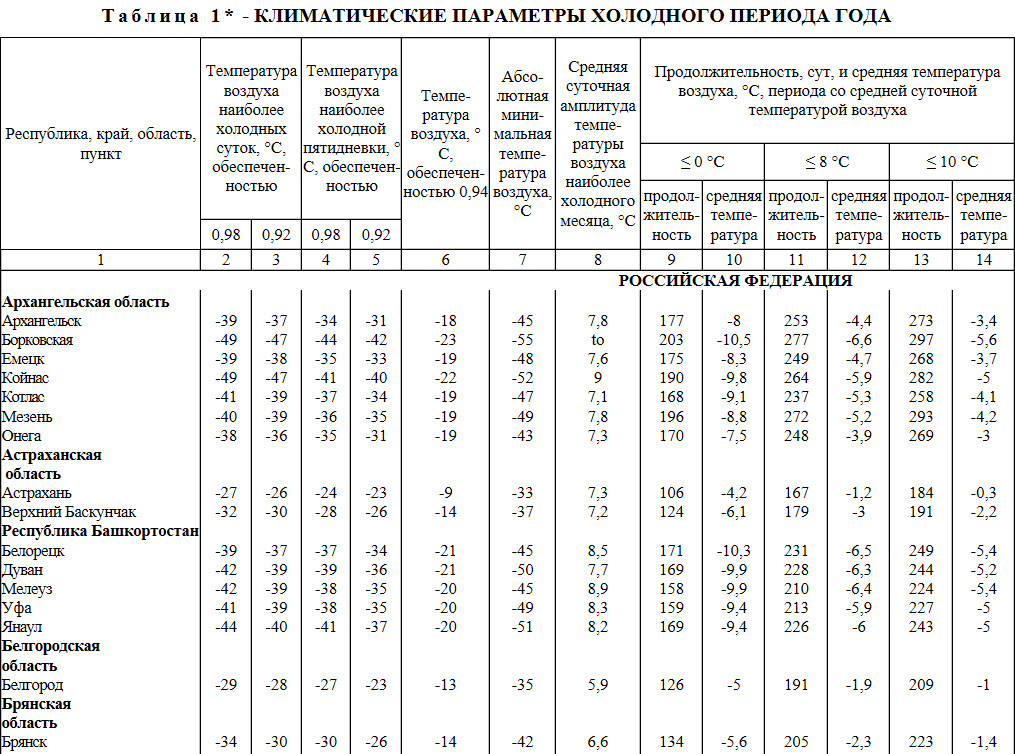
The duration of the heating season can be taken from table. 1. SNiP 23-01-99 (column 11). Although autonomous heating users can extend the season at their own discretion
Let's calculate the one-time costs for installing an electric boiler:
- boiler Thermotrust ST9 (9 kW, 380 V): 11 thousand rubles;
- connection to the heating circuit: 12 thousand rubles;
- connection to electricity: 2 tr.
The house has a power of 15 kW. When the electric boiler is operating, only 6 kW remains for all other consumers.
Considering that appliances (refrigerators, microwave oven, electric oven, electric kettle, washing machine, etc.) operate from 220 V, it is impossible to "scatter" the three-phase connection so as to guarantee them work.
In this case, you will have to incur additional costs:
- payment for technological connection of 30 kW at a standardized tariff rate of 157 rubles / kW: 5 thousand rubles;
- Payment for replacing the block of machines and installation of wiring around the house to the location of the boiler: 10 thousand rubles.
Total: NNS = 40 tr.
Let's calculate the one-time costs for installing a gas boiler:
- preparation of premises for a boiler room in accordance with regulatory requirements: 50 thousand rubles;
- gas boiler ProTerm 12 KSO (12.5 kW): 19 thousand rubles;
- installation of equipment and connection to the heating circuit: 25 thousand rubles;
- installation of a combustion products removal system (1.5 thousand rubles per 1 running meter): 12 thousand rubles;
- technological connection to the mainline: RUB 30;
- design and installation work on the site: 90 thousand rubles
- closing documents (project approval, registration) and calling a specialist: RUB 50;
- starting the boiler and setting: 5 tr.
Total: NG = 281 tr.

The term of technological connection to gas for the first category of applicants cannot exceed 1 year. Therefore, when entering a new house, you need to start the whole procedure in advance.
Considering the duration of the heating season of 191 days, to compensate for heat loss, it is necessary to spend 3500 × 24 × 191 = 16044000 W × h or:
- 16371 kWh. electricity with an electric boiler efficiency of 98%;
- 1816 m3 natural gas with a boiler efficiency of 95%.
With electrical heating, the annual heating costs will be:
- self-service of the boiler and minor repairs: 2 thousand rubles;
- payment for electricity at a tariff for rural areas 2.80 rubles. per kWh: 46 tr.
Total: LNS = 48 tr.
When heating with gas, the annual costs will be:
- boiler maintenance by a certified specialist and minor repairs: 5 thousand rubles;
- gas payment at a rate of 6.28 rubles. per m3: 11 tr.
Total: LG = 16 tr.
For the house in question, the time it takes for gas heating to equal the cost of electric heating will be:
T = (281 - 40) / (48 - 16) = 7.5 years.
Conclusions and useful video on the topic
The cost of gas and electric heating in the Kaliningrad region. Subsidizing connections for certain categories of citizens:
Prices and terms of connecting gas to a country house:
To justify the choice of an energy carrier, if it is possible to connect heating from both gas and electricity, it is necessary to carry out calculations of one-time and annual investments.
To do this, you will have to contact the companies supplying energy resources. Based on the data received, it will already be possible to build a cost schedule and objectively assess your financial capabilities.
And which version of the boiler did you purchase for the arrangement of the house / apartment? Share your own arguments that have become decisive in the choice. Please leave comments in the block under the test article, post a photo and ask questions on the topic of the article.
